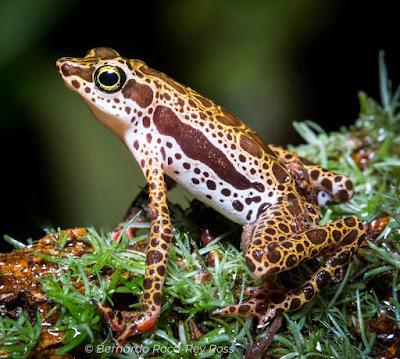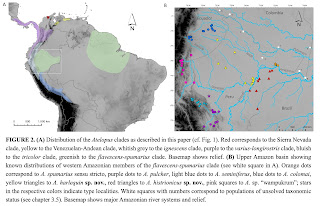 |
| Atelopus harlequin in Lötters, Böning, Bailon, Castañeda ... et Plewnia, 2025. |
Abstract
Harlequin frogs, genus Atelopus, are a species-rich group of bufonid anurans from the Neotropics with more than 100 species. For nearly four decades now, this group has suffered from massive population declines. Almost all species are threatened with extinction, and many populations and several species are considered extinct or possibly extinct. This results in a limited sampling available for studies on harlequin frog systematics, especially in terms of molecular genetic information. However, efficient conservation of harlequin frogs requires an improved taxonomy. This is further complicated through the circumstance that many Atelopus species are relatively poor in external morphological characters combined with a high level of intra-specific character variation (e.g. coloration and body size). At the same time, cryptic diversity exists with well differentiated species (supported by osteology and molecular genetics) almost indistinguishable by external morphology. We compiled the largest dataset to date for mitochondrial (12S, 16S, cyt b) and nuclear (POMC, RAG1) markers and present a phylogeny (likelihood and Bayesian inference methods) including 152 samples from 104 populations scattered over the entire geographic range of the genus. Four allo- or parapatric main clades are distinguished: I. Sierra Nevada; II. Venezuelan-Andean; III. Andean-Chocó-Central American (with the ignescens and the varius-longirostris clades); and IV Amazonian (containing the tricolor and the flavescens-spumarius clades). The phylogenetic relationships within these clades remain to be resolved. Taxonomic implications included both splitting and lumping, but taxonomic action is here only taken for populations related to A. spumarius from western Amazonia. Besides redescriptions of A. spumarius sensu stricto and A. colomai, we describe two new species based on morphology, skull osteology and bioacoustics. Additional yet understudied populations from Amazonia may be allocated to these species or may represent additional undescribed taxa.
Amphibia, Anura, amphibian crisis, cryptic diversity, Neotropics, integrative taxonomy
Atelopus histrionicus sp. nov.
Stefan LÖTTERS, Philipp BÖNING, Salvador BAILON, Jose Daniel Barros CASTAÑEDA, Renaud BOISTEL, Alessandro CATENAZZI, Juan C. CHAPARRO, Germán CHÁVEZ, Angel CHUJUTALLI, LAURENT COEN, LUIS A. COLOMA, ANDREW J. CRAWFORD, Jaime CULEBRAS, JUAN CARLOS CUSI MARTÍNEZ, JUAN MANUEL DAZA, IGNACIO DE LA RIVA, DENISE J. ELLWEIN, RAFFAEL ERNST, SANDRA V. FLECHAS, ANTOINE FOUQUET, JUAN MANUEL GUAYASAMIN, CHRISTOPHER HEINE, RAFAEL F. JORGE, ALISHA JUNG, KARL-HEINZ JUNGFER, NATHALIE KAFFENBERGER, HENRIK KREHENWINKEL, ENRIQUE LA MARCA, MARGARITA LAMPO, GUIDO F. MEDINA RANGEL, LUDVIG ORSEN, DANIEL J. PALUH, JOSÉ LUIS PÉREZ GONZALEZ, JONATHAN PERRIN, AMANDA B. QUEZADA RIERA, JUAN PABLO REYES-PUIG, Bernardo Roca-Rey ROSS, DANIELA C. RÖSSLER, LUIS ALBERTO RUEDA SOLANO, DAVID SALAZAR-VALENZUELA, JOSEFA CELSA SEÑARIS VAZQUEZ, MORGANE SOWINSKI, ANDREA TERÁN-VALDEZ, ANGIE TOVAR-ORTIZ, MICHAEL VEITH, PABLO VENEGAS, RUDOLF VON MAY, TIMM WEITKAMP and AMADEUS PLEWNIA. 2025. A Roadmap for Harlequin Frog Systematics, with a partial Revision of Amazonian Species related to Atelopus spumarius. Zootaxa. 5571(1); 1-76. DOI: doi.org/10.11646/zootaxa.5571.1.1





